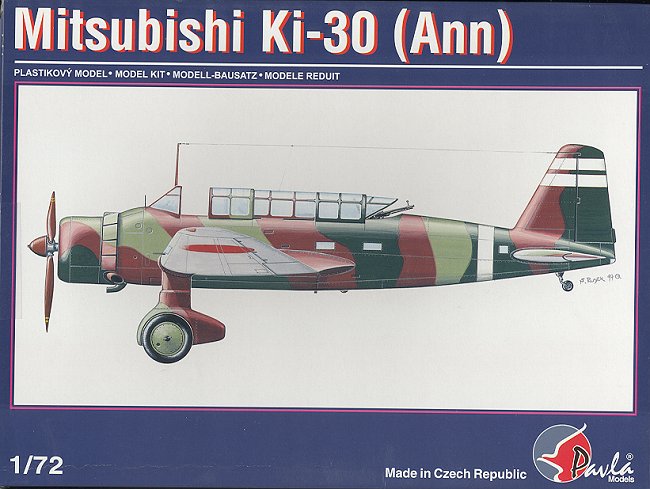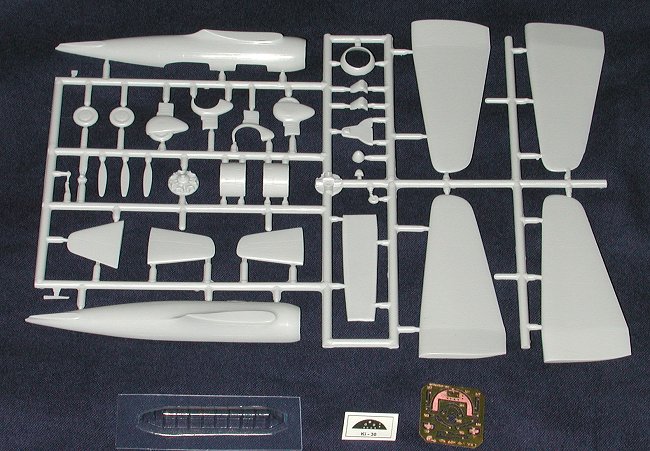
| KIT: | Pavla 1/72 Ki-30 'Ann' |
| KIT # | 72016 |
| PRICE: | $15.98 |
| DECALS: | Three aircraft: See review |
| REVIEW & | |
| NOTES: | Short run with photo etch fret and vac canopy |

| HISTORY |
When aviation enthusiasts get together and start to talk aboutthe Pacific war, one aircraft type that is almost never discussed is the Ki-30.This Mitsubishi light bomber was used mostly in China and against almost noopposition. Never mind that it was the JAAF's first aircraft with a twin rowradial, variable-pitched prop, internal bomb bay and split flaps. It just wasn'tinvolved in any real action. The aircraft was quite easy to fly so was muchliked by those who flew it. It was equally easy to maintain, so the ground crewsliked it as well.
The Ki-30 was introduced as a replacement to the Ki-2 and Ki-3during the mid/late 1930s. It came into service around the same time as theKi-27 fighter, Ki-21 heavy bomber and the Ki-15 reconnaissance aircraft. Inaddition to being a light bomber, it was also expected to be able to perform thedive bombing function, though not with as steep a dive angle as the Ju-87 Stuka,SBD or the IJN's D3A 'Val'.
The aircraft eventually served with six bomber Sentais and twoChutais. Over 700 of this little known aircraft were finally produced whenproduction stopped in mid-1940. At the start of the Pacific war, there werestill Ki-30s in use, some being sent to the Philippines once all air oppositionhad ceased. They were also used against French forces in Indochina in early1941. By the end of 1942, all were withdrawn from combat units and used as hacksor training aircraft. There were enough still around to be used in suicideoperations at war's end.
| THE KIT |

It was a Pavla kit that caused a friend to seriously consider giving upmodeling. Not really a rousing endorsement, but an idea of how much of achallenge a seemingly innocuous short run kit can be. Pavla's Ki-30 is one ofthe newer releases and appears to be a simple enough model to build.
Allthe plastic parts are on one tree and consists of nearly everything except thecanopy, (which is vacuformed) and some interior bits that are on the etchedbrass fret. The detailing consists of very nice engraved panel lines. It isquite likely that many of them will disappear under sanding and filling as theyare a bit shallow. The kit has the typical mold release pin marks in the largeparts and is surprisingly free of flash and obvious sink marks. Like most shortrun kits, there are no alignment pins and major assemblies are butt joined. Someof the smaller parts like engine exhaust have to be made by the modeler.
Acouple of things that I'm not particularly fond of. First of all, the rearmachine gun is made of three pieces of etched brass. I'd think that having itdone in plastic would be more realistic. Secondly, the prop. It is made ofseparate blades with a separate hub. The spinner is not one that encloses thehub so you have to glue these blades to this little lump of plastic that is thehub. Not exactly something that most of us relish. I'll be looking to see ifAeroclub has something in their catalog that will work!
Overall,it looks simple but is probably going to be a bit of a challenge to build. REFERENCES Model Art #533, Camouflage and Markings of the IJA Bombers. Exceptfor the title, the book is entirely in Japanese. Review kit courtesy of me and my wallet! If you would like your product reviewed fairly and fairly quickly by asite that has over 1,500 visits a day, please contactme or see other details in the